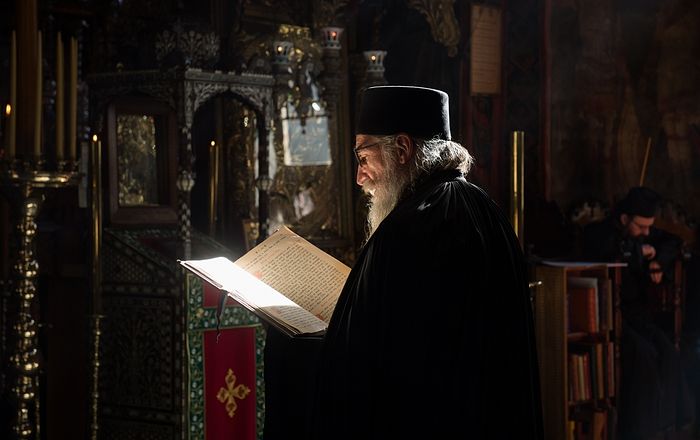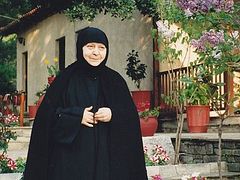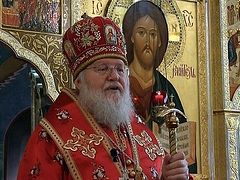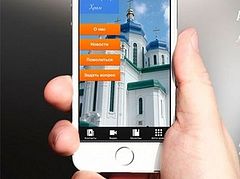We have all seen by now the disruptive reports describing in detail just how deadly and serious the coronavirus is. While that is true, the way that many within the Church are responding and, in particular, the guidance that we have received from many bishops, is disconcerting. We are directed now by hierarchs in several jurisdictions that the laity are to remain at home viewing the services via live-streaming, while the clergy are to serve a full cycle of services in near-empty churches, accompanied by a skeleton staff of altar servers and readers or singers. What is wrong with this picture?
We have suggested elsewhere that the live-streaming of the liturgy does great damage to the liturgical experience of the participant. We refer the reader to that writing and temporarily set that issue aside for the purposes of this essay. But we understand that the circumstances that we face are severe and require a creative and perhaps, unique approach. At the same time, whatever decisions are made about the liturgical life, although they may be only temporary, they must be consistent with what we know about the inner, essential life of the Church.
While historians grapple with many details of the life of early Christians, one of the most important things we know is that the worship of the early Church was conducted by Christians as a group, by coming together. This was true even in the time of persecution when assembling in one place posed great risk of arrest, torture and martyrdom. Clearly, the Church understood that gathering together was the means by which she manifested something essential about her nature. Since God had entered into a covenant with the people of Israel, the Church as the New Israel would inherit this unique relationship not as numerous individuals, but collectively as a people. Metropolitan John (Zizioulas) of Pergamon reflects on the significance of the names εκκλησία (Church) and εκκλησία του θεού (Church of God) that were applied to the early eucharistic community:
“A careful study of I Cor. 11 reveals that the term εκκλησία is used in a dynamic sense: "when you come together into, i.e. when you become, εκκλησία,” (v. 18.). This implies clearly what in the following verses becomes explicit, namely that the eucharistic terms “coming together," “coming together επι το αυτό,” “Lord's Supper," etc., are identified with the ecclesiological terms “εκκλησία” or “εκκλησία of God." The other consequence which, I think, is of great importance for later developments of the idea of catholicity is that this local community is called όλη η εκκλησία, i.e., the whole Church, already by Paul again.”1
In other words, the defining activity of the Church, as Church, was that she gathered together weekly to celebrate the Eucharist and, when she did so, all the members of the community were present. The curious little phrase επι το αυτό (“together in one place”)2 has come to be identified with Nicholas Afanasiev, who wrote extensively about it.3 Yet it was Afanasiev’s student, Alexander Schmemann, who reminds us most pointedly in his magisterial work, The Eucharist, that “the very word “church” — εκκλησία — means “a gathering” or “an assembly,” and to “assemble as a church” meant, in the minds of the early Christians, to constitute a gathering whose purpose is to reveal, to realize, the Church.”4
This gathering was not accidental and the role of the leader, who stood in first place and presided at the gathering, was precisely directed at those who stood before him as members of the Eucharistic community and as partakers of the Eucharistic meal. It was on their behalf that he offered the thanksgiving and it was among them that the offering was distributed. Thus Afanasiev:
“All of the faithful celebrate the Eucharist in the assembly but this celebration of all is manifest through one person. This is the nature of any celebration in the Church. The one who offers thanks is always one, but others concelebrate with him. The celebrant at the eucharistic assembly was the one who occupied a central place at the gathering. He “offered thanksgiving” in which all took part. He was always one and always the same but also always together with all. The people of God could neither celebrate without him nor could he celebrate without them, for not only he himself but all were priests of the Most High God.”5
The sense of importance that Liturgy only be celebrated when all members of a community are gathered together in the same place eventually manifested itself in two, related liturgical rules: (1) a priest or bishop is forbidden from serving the Liturgy more than once on the same altar on the same day,6 and (2) a priest or bishop is forbidden from serving the Liturgy privately, by himself.7 The first of these prohibitions honors the communal aspect of the sobor, which would necessarily be diminished if more than one gathering were to occur. Each parish or church ought to have but one service at which all members partake, in order that the catholicity of the Church be revealed:
“As a combination of the existing fragmentary liturgical evidence of the first centuries allows us to know, the “whole Church” “dwelling in a certain city” would “come together” mainly on a Sunday to “break bread.” This synaxis would be the only one in that particular place in the sense that it would include the “whole Church.” This fact, which is not usually noted by historians, is of paramount ecclesiological significance, for it immediately draws the line of demarcation between the Christian and the non-Christian pattern of unity at the time of the early Church.”8
The second prohibition does much the same, marking the Liturgy as the distinctive, public prayer of the community as opposed to the personal prayer of the individual cleric:
“But can a bishop or a presbyter celebrate the divine services alone, without God’s people? To answer this question, one should first determine just who actually celebrates the sacraments and divine services in the Church... The Liturgy and the sacraments are celebrated by the Church and in the Church, in the assembly of the people of God. This means that the Liturgy and the sacraments are celebrated in the ecclesial assembly by God’s people, which includes both laics in the narrow sense of this word and the ecclesial hierarchy, all calling upon God in prayer... A bishop or a presbyter, presiding over the people of God, celebrates the sacraments only together with the people without whom their role as presiders would be a mere phantasy.”9
Thus we see that to preside at the Liturgy by definition means to stand in first place (proistamenos) before the community gathered together. Now we know that the current health crisis that confronts the Church makes it impossible, or at least, highly dangerous, for the members of the community to gather together in person. Consequently, the question presents itself whether, under these extremely unusual circumstances, the clergy may be permitted to serve the Liturgy in the absence (or near-absence) of the laity, when only a very small number of laypersons are present, the rest having been barred from attendance. As a practical matter, we have seen for weeks now that the clergy have been instructed to do this and that they have been in fact regularly serving the full cycle of liturgical services with a skeleton crew of singers and altar servers. What are the ecclesiological implications of these decisions?
Without meaning any disrespect to those hierarchs who have struggled to guide the Church through these stormy waters, or to the many clergy members who have diligently given of themselves by tirelessly serving these services and placing themselves in harm’s way in order to minister to those who may or may not be ill, we are concerned that the following questions may not have been asked or fully considered:
-
Does the current practice of serving in the absence of the laity violate our historical understanding of the role of the clergy as servants and minsters (who are the clergy serving, and to whom do they minister in this situation)?
-
Keeping in mind that clergy and laity have different functions, has this practice improperly separated the clergy and the laity and assigned to them different purposes, privileges or identities?10
-
If the Church cannot gather and constitute herself, is there a meaningful and necessary reason for the clergy being required to serve a full cycle of services in an empty Church?
-
Have we accepted a liturgical theory of representation whereby the few laypersons present represent the laos tou theou (the people of God), who have been barred from attendance?
-
Has the Liturgy, the great “catholic” prayer of the Church, been reduced to being part of the private prayer or personal devotion of the priest?
-
Have the laity been demoted to mere viewers of a liturgical ritual enacted without them and observed by them from a remote location, so that they can no longer co-minister and participate?
-
Is it actually impossible, under these circumstances, for the sacraments to be administered to the laity?
-
When Holy Communion is offered under such circumstances, with the overwhelming majority of the laity absent, what is the ecclesiological significance of the Mystery since, by its definition, it ought to reveal the profound and mysterious unity that Christians experience, which overcomes our multiplicity and fallenness (i.e., the Sacrament of the Church)?11
-
By serving under these circumstances, have we eliminated the potential for evangelization, since members of the laity and visitors are temporarily not welcome?
-
Has the “community,” “sobornicity” and “conciliarity” of the liturgy been extinguished or obscured by these practices?
-
Finally, when the liturgical ethos of the Church is truncated and reduced in this manner, is it inappropriate to celebrate at all under these conditions, when such celebration will be out of character with the complex choral, material and liturgical traditions with which it is seamlessly a part?
Regretfully, we feel forced to conclude that the answer to most, if not all of these questions, is yes. Understandably, some of these questions are addressed by the decision of the hierarchs to require live-streaming of the services, which presents its own, unique problems. Nevertheless, it appears to us that a great harm is visited upon the Church by permitting our liturgical tradition to be celebrated in this fashion. Simply put, the laity is an essential, non-negotiable part of the Church and, in its absence, the Church is tragically reduced so that she can no longer manifest the fullness of her identity. That said, we recognize that many parallels can be drawn between the current situation and those historical situations—the Catacomb Church, the Turkocratia, the Communist Yoke—when the Church could barely function and extreme measures were necessary. We also recognize that there are exceptions to every rule and that in certain cases (for example, solitary monks) it has been possible [for them] to celebrate the Liturgy in private or with no members of the laity present. But these are discrete, highly unique circumstances in which exceptions may be necessary and good. The current situation (the Coronavirus) is distinguished from these historical anomalies (if we may refer to them as such) insofar as in this present situation we have seen the Church embrace an approach that is literally in effect on all continents and in every Orthodox Church. Accordingly, because it is so widespread and uniformly adopted (temporarily we hope) that we must raise these questions, inconvenient as they are, since our liturgical discipline is so uniformly challenged. If this was happening in just one or two places and for a short period of time, we might be inclined to overlook it or consider it a stopgap measure of no consequence. However, we have at present no clear indication of when the situation will be reversed or redressed.
We should pause here to note that throughout her long history, the liturgical practice of the Church has been significantly varied. We do not mean to suggest that at every time and place the role of the laity has been manifest to the same degree. Nor do we wish to imply that in any way the Liturgy is not effective or efficacious at times when members of the laity are absent. Whenever it is celebrated, the Divine Liturgy is the meeting of the whole Church, living and departed, earthly and heavenly, the Communion of the Saints, bringing together those who are present and those who are absent. We have all celebrated or attended Liturgies at which very few persons were present, but which nevertheless seemed to be such meaningful moments in which all of life was recapitulated and referred back to God’s Kingdom. Feast day Liturgies, for example, are a notable example of services which are typically very poorly attended however, this is due to the laypeople having other things that they want or need to do, not to the fact that they have been locked out of the church. On such Feast days, they would be very welcome to attend and their absence is a thing of sadness and loss for the community.
What then is the alternative to celebrating in the absence of the laity, as has been authorized and required during this pandemic? It appears to us that in this situation, the essential conditions for celebrating the Liturgy simply do not exist. In closed communities such as monasteries, it is completely safe and appropriate to continue to serve a full cycle of services. Parishes that can imitate in some degree, the isolation and distancing that is typical of a monastic community, could certainly continue to gather and celebrate. However, the majority of parishes, and large, urban communities and cathedrals would seem to be places where, for a time, it would be best for them (as painful as this is) to be closed and the liturgical life suspended indefinitely.12 Why is this necessary? It is necessary for a profound, theological reason, because an essential part of the Church community is missing and without that part, the Church cannot fulfill herself and manifest her identity as a holy nation, the people of God.





